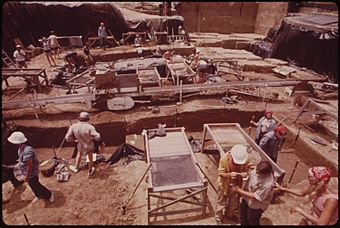Koster Site facts for kids
Quick facts for kids |
|
|
Koster Site
|
|

College students and archaeologists at the Koster Site in 1973
|
|
| Location | 200 yards (180 m) east of the Eldred-Hillview road, 5.5 miles (8.9 km) south of Eldred |
|---|---|
| Nearest city | Eldred, Illinois |
| Area | 25 acres (10 ha) |
| NRHP reference No. | 72000460 |
| Added to NRHP | June 19, 1972 |
The Koster Site is a very important archaeological site in Illinois. It is located south of Eldred. This site is like a giant history book buried deep underground. It covers more than 3 acres and goes down about 30 feet into the soil.
Between 1969 and 1978, archaeologists dug here. They found amazing evidence of human life from very old times. These times include the early Archaic period (around 7500 BC) up to the Mississippian period (around 1000 AD). The soil layers at Koster are special. They contain 25 different levels where people once lived. Each level is separated by more soil, which kept everything very well preserved.
Contents
Unearthing Ancient History
A Deep Dive into the Past
The Koster Site is famous for its many layers. Each layer tells a story about a different group of people. It shows how they lived, what they ate, and what tools they used. Finding so many layers in one place is very rare. It helps scientists understand how life changed over thousands of years.
Amazing Discoveries at Koster
One of the most exciting finds at Koster is an ancient cemetery. It is one of the oldest known burial sites in eastern North America. This cemetery showed that early Archaic people had special ways to bury their dead. They often buried many people together in mounds.
Other important discoveries were also made. Scientists found early proof that North Americans used stones to grind food. They also found evidence that people kept domesticated dogs. Three dog burials were found at Koster. Another was found nearby. These dog remains are about 9,900 years old. They are the oldest dog remains ever found in the Americas.
Life in an Ancient Village
The things found at Koster suggest it was a large, permanent village. Archaeologists found signs of homes that people lived in all year round. They also found items that were too big or heavy to move easily. This means people stayed in one place for a long time.
Many stone tools were also found during the digs. These tools were used for different daily tasks. They also showed that people lived there for many years. Before Koster, many scientists thought early inhabitants were mostly nomads. Nomads are people who move from place to place. But Koster helped change this idea. It showed that some ancient people lived in settled villages.
The Discovery of Koster
The Koster Site was found in 1967. It was on the farm fields of Theodore and Mary Koster. The site was named after them. Northwestern University anthropologist Stuart Struever discovered it. A local farmer gave him a tip about interesting artifacts. Struever then found the rich historical treasures hidden beneath the cornfields.
Struever had recently started the Center for American Archeology. This center is located in Kampsville, Illinois. Under his leadership, the Koster Site became a huge excavation. It drew over 10,000 visitors each year. It is considered the most important discovery by the Center for American Archeology. The Koster Site was added to the National Register of Historic Places on June 19, 1972.




